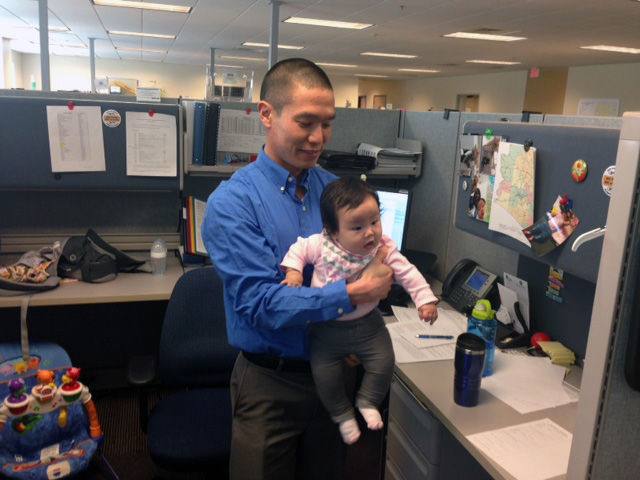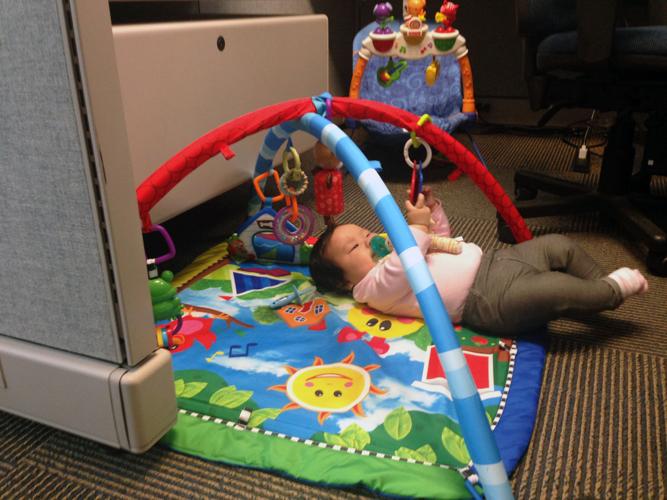PHOENIX – Babies cooing in strollers and on brightly colored play mats in their parents’ cubicles are commonplace at the Arizona Department of Health Services.
Co-workers gather during breaks, playing with one another’s infants.
Babies attend meetings and lay calmly — and other times not so calmly — as their parents go about their normal work routine.
Six-month-old Katelyn Watanabe lay on her mat, staring up at dangling plastic shapes hanging just out of her reach. Kevin Watanabe, her father, was within arm’s reach, sitting in his swivel chair, typing away on the gray desk in his cubicle.
“Knowing that she’s here with me I don’t have to worry about who she’s with,” said the 32-year-old nutrition consultant in the women, infants and children department.
“Having the interaction with her, having that one-on-one time, is beneficial to us,” Watanabe said.
Babies up to 6 months old have been the norm at the health agency for more than 15 years.
Three more state agencies officially opened workplaces to employees’ infants in January: the Arizona Department of Economic Security, the Department of Water Resources and the Arizona Health Care Cost Containment System.
Bringing babies to work has its benefits, including boosting employee morale, creating crucial bonding time for parents and reducing worries and costs about child care, advocates say, but it doesn’t work for every worker, infant or workplace.
HOW IT WORKS
Parents have brought more than 200 babies to work at the health agency since 2001, when the infant-at-work program was established. The program began as a way to encourage mothers to breastfeed and gradually expanded to allow parents, grandparents and foster parents to bring infants to work.
About three to 15 babies are at work at any given time among the 1,400 health-service employees, according to agency director Dr. Cara Christ.
“You can see the office dynamics change,” Christ said. “People are happier and workplace morale increases with the baby around.”
Program requirements vary by agency and department, but generally parents bring their own supplies and must stay with their babies at all times.
Gov. Doug Ducey supports the program.
“It’s a win-win-win – increased productivity, quality employees less likely to leave state service, and most important — happy babies,” Ducey said in his State of the State address.
BABY BENEFITS
Christ said parents often come back to work sooner because of the program. Christ brought her baby to work and returned from maternity leave 5½ weeks after her daughter was born even though she had 12 weeks of paid leave.
When her daughter was “retired” from the program at six months, Christ said she and her colleagues were sad to see her go.
“It makes it more than work when you’ve got people that’ve held your baby and have comforted your baby and have watched them grow for six months, ” she said.
Watanabe, talking a few days before his daughter aged out of the program, shared Christ’s sentiment, saying his colleagues were quick to help him out with Katelyn.
Watanabe said Katelyn didn’t sleep much at the office because she enjoyed the interaction with his co-workers.
He said the father-daughter time was priceless.
“I came back a week after she was born just because I knew that I would have all of this time to be able to spend with her at work,” Watanabe said.
WHEN BABIES AT WORK DON’T WORK
The infant-at-work program comes with its challenges. Not all spaces are appropriate or safe for babies and Christ says not all babies are ready for the working world.
Christ had two babies go through the program. One was the perfect candidate and stayed cool, calm and collected in the workplace. The other: not so much.
“A baby may get a little bit fussy in a meeting and moms and dads will step out and excuse themselves,” she said.
The program is limited to newborns and babies no older than six months because babies spend most of their time sleeping, Christ said.
“They’re not very active. They’re not mobile. They’re contained. They sleep. They eat,” Christ said. “At about six months is when they start to crawl and sit up and want to interact and that’s when we’ve noticed it’s harder to continue to do the job with the baby at work.”
The program is open to employees who don’t work face to face with clients, but employees must get permission from their immediate supervisor before the department’s assistant director signs off on it.
Christ says it’s important to make sure the environment is safe for a baby and that its presence won’t affect the employee’s productivity.
“It’s not a one-size-fits-all policy,” she said. “Each employee should find out what works for them.”
WANTED: WORK-LIFE BALANCE
About six in 10 parents with infants or preschool-age children say it’s hard to find affordable, high-quality child care in their community, according to a 2015 Pew Research Center report. Half of full-time working fathers reported having too little time to spend with their children, the report says.
For mothers, work arrangements are linked to how they feel about the amount of time they have to spend with their children, according to the report. It found that almost 40 percent of full-time working moms wish they could spend more time with their children.






